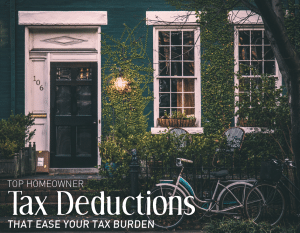
Homestead
Homeowner Tax Deductions

You can’t avoid paying taxes, and we all need to pay our fair share. However, paying your fair share shouldn’t place an unjust burden on you. As a homeowner, your tax burden is doubled because you pay both income and property taxes. To decrease that burden and boost your tax savings, take advantage of these homeowner tax deductions. As a result, you can use your tax savings to go on a vacation, increase your child’s college fund, build upon your retirement fund, or complete another home improvement project.
Home Improvement Tax Deduction
You spend so much of your time at home, and you try to make it as comfortable a place to live as possible. If your home needs some upgrades, consider improvements that will help foot the bill for themselves.
You can get an energy-efficient tax credit of up to $500 for installing storm doors and energy-efficient insulation and air-conditioning and heating systems. Switching out your old windows for energy-efficient ones could earn you $200. This credit expires this year on December 31st. So, this year will be your last chance to take advantage of getting tax credit for making your home more energy efficient.
Also, installing equipment that uses renewable sources of energy makes you eligible for the Renewable Energy Efficiency Property Credit. The credit covers 30 percent of the cost of equipment and installation. This credit also expires this year on December 31st.
Mortgage Interest and Refinancing
If your mortgage payment makes you cringe each month, you’ll be glad to know you can deduct taxes on the following:
- Interest towards mortgage
- Mortgage payments for additional property
- Rental properties
- Refinancing and home equity lines of credit (HELOC) up to $100,000 of debt.
- If you own multiple properties, the mortgage interest on additional property is deductible as well. The cool thing is that it doesn’t have to be a house. It can be a boat or RV; as long as it has cooking, sleeping, and bathroom facilities, it counts as additional property.
Regarding using your second home as a rental, you need to vacation at least 14 days at the property or spend more than 10 percent of the number of days you rent it out.
Furthermore, you can claim points on your mortgage the year you paid them if the following happened:
- The loan was to purchase or build your main home
- Payment of points is an established business practice in your area and the points were within the usual range
Property Taxes
Now, this is the big one. Property taxes you pay each year are tax deductible. The amount of property taxes you paid for the year shows up on your lender’s annual statement. You must deduct them as an itemized expense on your Schedule A tax form.
First-time home buyers, look at your settlement sheet to see additional tax payment data. You may deduct the portion of property taxes you paid during the first year of your homeownership.
Protesting Your Assessment to Lower Your Property Taxes
Although you must pay property taxes, you can make sure that you pay a reasonable amount based on the true value of your home and land. Many homes get overvalued because assessors err in valuing a home and homeowners don’t pay attention to these mistakes. Consequently, homeowners unwittingly pay more than they should in property taxes.
However, if you’ve owned your home for more than a year, you can potentially lower your property tax burden by showing that your home has been overvalued, meaning that your tax assessment claims your property is worth more than it is.
Even if the number on the tax assessment seems close, you should still consider protesting your property tax. Typical savings from a successful tax protest is over 15%!
According to SmartAsset, the national median property tax paid is roughly $2,839.00. That’s about 1.192 percent of a home valued at $238,200.00.
If you’re able to reduce your assessed value by 15 percent to $202,470.00 and consequently save 15 percent on your tax bill, your new tax bill will be about 2,413.00. That’s a savings of $426.00!
To get started protesting your property tax, read your assessment letter. Your assessment letter will list data about your property and the assessed value of your house and land. Make sure your assessment letter has the correct information about your property.
Understanding that assessors can make mistakes assessing your home value will help you with your appeal. There are three key mistakes assessor make when assessing property. These mistakes include:
- Outdated Historic Sales Data: Sometimes assessors will use sales data from previous years. Because the real estate market is fluid, this data changes quickly, as a result; this data can over value your home.
- Mass Appraisal Methods: Also, when assessors use mass appraisal methods, they do not take into account all the market adjustments that occurred over time. Consequently, there sales data can’t always produce useful comparable properties to set future sales.
- Living Area: Assessors notoriously make mistakes about the living area of your house. This is especially true if you live in a 1.5 or 2 story home. Check any previous appraisals to ensure correct measurements and description of our home. Does the assessment letter show the right number of bathrooms and bedrooms? Does it report the correct size of your lot? .5 acres differs greatly than 5.0 acres.
After reading your assessment letter, consult a Realtor. We can find three to five approximate values of comparable properties similar to yours, and these comps can then be used to support your claim that your home is overvalued. This is especially useful if the assessor used poor historical sales data.
You’ll have 30 days to file an appeal of your assessment, so you’ll want to get the comps as soon as your assessment arrives. You can speak with an assessor on the phone or request a formal review.
You’ll then need to fill out a form and follow specific instructions regarding your supporting evidence. Typically, it’s not necessary for you to appear at the review. The review can take one to three months to complete, and you’ll receive a decision in writing.
The majority of assessment appeals are successful. However, if at first you don’t succeed, appeal. You’ll need to pay a small filing fee for an independent appeals board to hear your second appeal. This process could take up to a year to complete, so you’ll need to decide whether it’s truly worth it.
As a homeowner, you have plenty of options available to decrease your tax burden. The benefit is that you can use your tax savings for major life events such as weddings, vacations, and home improvements.
To find out more about your tax saving options as a homeowner, check out tax information for homeowners. You can also contact me directly and I’ll gladly lead you in the right direction towards saving you money on your taxes.
Anderson Cannon Featured on The Aha Connection

Aha! Connection Recipes You Will Love – Anderson Cannon
Karen Cannon Realtors Sponsors 2016 Taste of Dunwoody
Taste of Dunwoody Benefiting Children’s Healthcare of Atlanta
KCR is proud to be sponsoring 2016’s Taste of Dunwoody! This fantastic event will be held on February 20th at the Westin Perimeter Hotel and benefits the Children’s Healthcare of Atlanta (CHOA). Join us in supporting CHOA by attending this fun food filled event! –> Purchase Tickets for the Taste of Dunwoody
National Real Estate Market Primed for Expansion in 2016

Despite existing-home sales dropping last November, the National Real Estate Market is primed for expansion in 2016. Here’s why. Better weather in many parts of the country resulted in an increase in single-family and multifamily home construction. Also, the population of millennial homebuyers is expected to grow in 2016. This means increased demand to help the housing market see positive gains. With unemployment steadily decreasing, orders for new durable goods increasing 3 percent, inflation staying level, and income beginning to grow, the Fed decided to raise interest rates. The rate increase signals that our economy is getting stronger. So, don’t let the drop in existing-home sales in November fool you, with a stronger economy home sellers can expect eager home buyers in 2016.
Millennial Home Buyers
The low demand in November meant that first-time home buyers had only a 30 percent share in demand, which is slightly down from 31 percent in October and last year. However, in 2016 home sellers saw an increase of first-time home buyers enter the housing market because of the growing segment of millennials between 25 and 34 years of age. The Census Bureau projects that the population of millennials aged 25 to 34 will increase by an average of nearly 500,000 per year in the second part of the decade. Also, NAR’s inaugural quarterly Housing Opportunities and Market Experience survey reported that a large majority of millennials between 25 and 34 years of age who rent want to own a home in the future.
Interest Rates
The Federal Reserve raised short-term interests this month. Freddie Mac reported that the average commitment rate for a 30-year, conventional, fixed rate mortgage stayed below 4 percent, but rose from 3.80 percent to 3.94 percent in November. Mortgage rates are expected to rise to 4.50 percent by the end of 2016, but this rate is still historically low; a full percentage point below the rate during the recession of 2008. The low fixed mortgage rate should help spurn demand and encourage first-time home buyers to enter the market. But while the rate is at its current level, potential home buyers should keep an eye out for rate increases so that they’re not caught by surprise when the spring buying season comes around. Early 2016 would be a good time for home buyers to start looking to purchase a home.
Mortgage Lenders & Home Buyers
Fannie Mae’s fourth quarter 2015 Mortgage Lender Sentiment Survey™ shows that lenders expect to ease mortgage credit standards for GSE-eligible loans and government loans over the next three months. This should reduce the affordability problem for first-time home buyers. As a result, this will help young adult homeownership. Although home prices will be high, all of this is good news for home sellers because they should expect an increase in demand for their home.
In 2016, the first-time home buyer will have mortgage credit options available that were not available during the housing down-turn. First-time home buyers will have low-and no-down-payment mortgage loans available to them. Some loan options available include FHA loans and the conventional 97 percent program offered by Fannie Mae. Qualifying first-time home buyers need only to put 3 percent down on a home.
Homeowners
According to the Mortgage Bankers Association weekly survey, the Refinance Index increased 11 percent compared to the previous week. So it appears homeowners have anticipated the Federal Reserve’s increase in interest rates. If you’re a homeowner with an adjustable-rate mortgage or a variable home equity line of credit, you should expect your rates to rise in 2016. The first part of 2016 will be a good time to refinance. Home equity lines of credit (HELOC) are both fixed and variable. Variable HELOCs are tied to the Federal Reserve prime rate. Whereas fixed HELOCs are not. By refinancing early in 2016, you’ll afford any major life events that may occur such as daughter’s wedding, high college tuition, or home renovation.
Wrap-up
The National Real Estate Market is on its way to expanding. The Federal Reserve raising interest rates indicates optimism in the housing market and the economy as a whole. The 2016 housing market will remain a sellers market that should see an increase in first-time home buyers entering the market because of the strong desire of homeownership by millennials 25 to 34 years of age, and easing credit standards and increases in wages. Homeowners with variable mortgage rates should expect their rates to rise in 2016, but early 2016 will be a good time to refinance so that you’re that you won’t fill the brunt of further interest rate increases.
